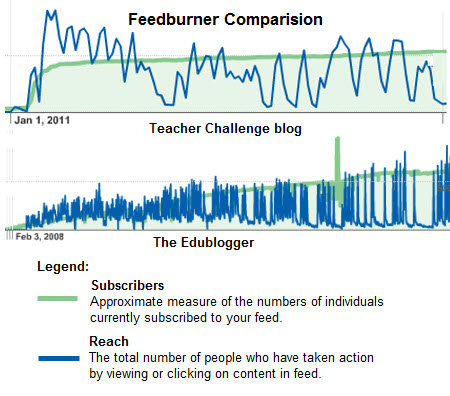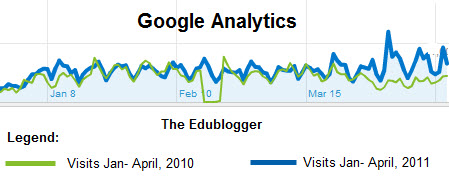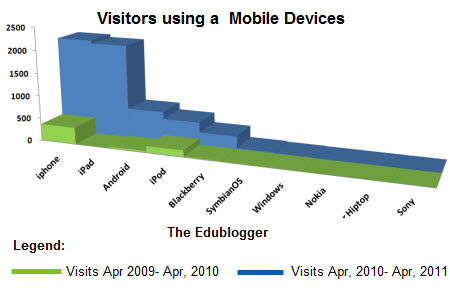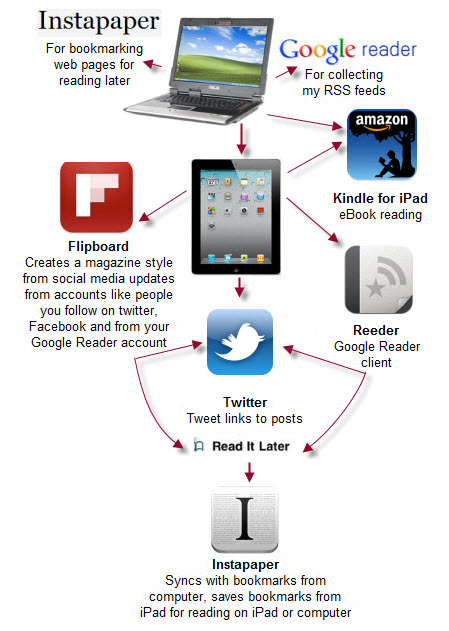Building readership on our new blog, set up this year, compared to the The Edublogger in 2008 – has fascinated me.
It has really highlighted the extent of our changing blog reading habits!
These do have implications for building our readership!
So what have I learnt?
We’ve changed how we use RSS
There’s been considerable chatter the past year that RSS is dead, dying or not doing so well.
Maybe in other blogging niches it’s doing well but in the edublogosphere she’s struggling.
Feedburner subscriptions on the Teacher Challenge have barely increased since we’ve set it up and 70% of these are email subscribers. Similarly, The Edublogger subscribers haven’t increased much for the past year and I’m seeing the same trend on blogs of other well known edubloggers.

The simple truth is we’re less likely to use RSS or email subscription now compared to our RSS usage in the previous era of the Web. We’re just less into RSS readers and start pages.
Am I saying throw away your RSS and email subscription options? NO!
You need them for those readers that prefer these options. And I still believe that all educators need to learn about RSS as it does make managing students’ work online considerably easier.
We’re using real-time web & social networking more
We’re far more social now and more likely to use social network sites like Twitter and Facebook as a buffet.
Consuming whatever we want at our leisure by selecting posts from links shared by our networks.
So while we’ve struggled with RSS we’re getting good site visits on our new Teacher Challenge blog and it’s easy to see the increase in visits to The Edublogger this year compared to the same time period last year.

So what does this mean?
- Increased traffic to blogs and posts compared to when we were more reliant on RSS
- Less likelihood that our posts will be read if we’re not an active part of the edublogosphere and aren’t social networking with others
My advice:
- Make sure you know how to use tools like Google Analytics to monitor your blog’s traffic
- Be an active member of the blogging community by taking a genuine interest in other blogger’s work, hyperlinking your posts to other bloggers’ content and making time to leave meaningful comments on their posts – read Scott McLeod’s great advice here.
- Learn how to use Twitter well
- Add social tools like Tweetmeme, Facebook Like, ShareThis to your blog to make it easier for readers to share with their network!
- Look at how you might use other social networks like Facebook to interact
- Learn how to monitor the social engagement of your posts using tools like Post Rank — you can check out The Edublogger’s PostRank and Teacher Challenge PostRank metrics here!

We’re using mobile apps and mobile devices more
Mobile devices like iPhones and iPad have changed how we’re using the mobile web.
No longer is the mobile web the realm of the geeks —these devices made it easy and they’re becoming increasingly ubiquitous.
And they’re starting to change blogging reading habits in a big way!
Check the growth in visitors to The Edublogger using a mobile device over the past year.

So what does this mean?
It’s important to understand how readers are using their mobile devices to consume content.
No! I’m not telling you to rush out to buy an iPad or iPhone… unless you want me too? 🙂
Instead I’ll explain how it’s changed reading habits for people like me.
Firstly I no longer read books — they’ve been replaced by ebooks.
Nowadays most posts are read while relaxed lazing on the couch or in bed on my iPad. It’s more enjoyable, faster and easier to scan through the content.
And when I’m out and about, and bored waiting for an appointment, I’ll pull out my iPhone to access my content on it!
Here’s my Computer – iPad work flow:

The key with mobile devices is how we use and our preferred apps is very personal.
Final Thoughts
The world’s a lot different from when I first started blogging in 2007. Our readers are changing and we need to be evolving with them.
Would love to hear your thoughts!
- Have your reading habits changed?
- Have you noticed the same types of changes to your blog’s metrics?
- What advice would you give others on building readership?
If you are enjoying reading this blog, please consider ![]() Subscribing For Free!
Subscribing For Free!
Thank you for head up this great article. I’ve enjoyed reading this, will try to improve my writing for my visitor and loyal readers soon.. 🙂
Interesting post. The problem for me is the constant fragmentation of communication. Too many social networks, too many operating systems, too many apps, too many devices, not enough time. Or interest. I have had a google plus account for quite some time, but I never use it. Ditto for Twitter. I still cannot figure out the true value of a facebook page. Much of the social networking seems like a huge time suck for me. I just want to use a very few tools well, rather than try to keep up with every new social tool iteration and use it halfway or not all all. The gadget and social web 2.0 universe is tool cluttered.
Interesting thoughts and facts. My personal usage – I use a combination of social media and rss subscriptions for information. I think there are more choices available today as compared to a few years ago.
I use TwitterDeck more often these days because I get varied and more instant information. I have not abandoned rss feeds completed. They are still very useful but we have more choices now. I also get information by subscribing to podcasts. Podcasts are useful when I am on the move. I listen when I am driving.
Many typo and grammatical errors in this piece. A good proofreading will lead to a more readable piece.
Thanks for your feedback Peter and I asked my twitter followers to suggest changes since many of them are educators. I’ve now made those changes as per their suggestions.
Please feel free to let me know if there are any other typos or grammatical changes you would recommend.
@Ronnie hehe and I’m the biggest offender with the getting it right aspect. Which really frustrates me because it changes so much when view by a feed.
@Countryfun and MsBee Totally agree; you can become really consumed worrying about readership. The key really is to focus on what are you trying to achieve and then working on making it happen.
@Susan Great to hear you have a similar work flow on your iPad compared to me. I think the social networking aspect is perhaps even more important on educational bloggers than niche areas — but maybe I’m wrong?
@Michael Glad this post has intrigued you! This is one post I really enjoyed writing because I spent a lot of time analysing the information and reflecting on what it all might mean. It truly hadn’t hit home how much our online habits had changed until I saw it in action with the two blogs.
@Craig and Chad Thanks for the nice feedback about my post. Hope you do find the information has helped!
I was really intrigued by this post as it reflects some of my own changes to blog readership & blogging itself.
I started using Twitter about 6 months ago, and discovered that it is an incredibly powerful medium for attracting readers to my reflective blog. I also regularly use it to catch up with ‘good blogs’ written or recommended by my PLN.
For me, RSS is a handy way of collating blog feeds; however, I was recently forced to reduce the number of blogs I follow because of an excessive build-up of unread materials. I am now much more likely to keep an eye out for new blog post notifications on Twitter, and follow up from there.
In short, I may not (and can’t) follow everyone using RSS, but I’ll certainly keep an eye out on Twitter.
Thanks for the info! I have been on twitter for 4 months and am new to blogging (2 posts so far) so this was a great post for me. I laughed when I read your computer-iPad workflow because I do the exact same thing! Although I subscribe to many blogs via RSS I frequently visit blogs that I read about on twitter so although I don’t have a long term frame of reference your comment about the importance of using social networking to build a blog audience rings true to me.
Hi
Great blog – thank you – it has inspired me to start my own educational reflection blog – would love some new followers – http://mrkempreflects.blogspot.com/
Cheers
Craig
Interesting reading. Last week I stepped back and really looked at what I wanted to achieve with my blog(s). I have decided to not worry about quantity of readers, but do the best by those that regularly use me – parents.
To remain involved in the broader blogging world (my world-wide staff room) I have set up side blogs that allow me to connect with different populations than what my primary blog serves.
I agree and seem to be at the same point as you, “countryfun”. This time last year, I was all consumed by the number of hits on our blog. Certainly the audience and genuine readership was a draw card for the children in my class and certainly inspired them to write and improve their writing. But, the shift I see now is that the children are looking for discussion with return visitors. They are becoming very aware that if their readers are coming back, they must be doing something right… This has lead to children becoming more critical about their purpose for sharing and the their audience. Needless to say, I will still make calls on my PLN via social networking for those special moments but right now, the class is enjoying the idea of sustaining their readers and giving them want they want 🙂
The take-away for me in this post is that our readers use so many different ways to get the content we write (email, rss, facebook, mobile, etc.).
When writing a post, we can spend forever getting everything to look just right, along with setting up themes, widgets, and sidebars. But a huge number of our readers might never see any of these things! Definitely interesting to think about…
I really enjoyed this post. Definitely some great ideas that I’ll be implementing more and more!